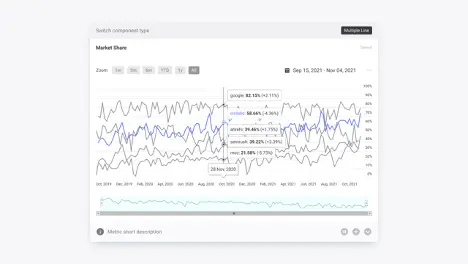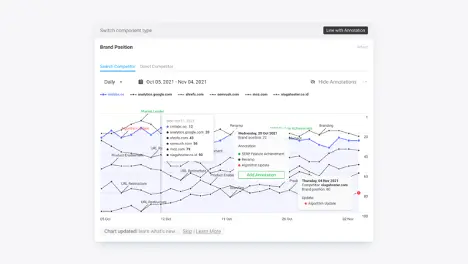The role of SEO should not be underestimated in managing online businesses today. Oftentimes, the numbers of clicks and engagements help raise brand equity for businesses. In return, its competitiveness increases in the market as well.
So, how does Google measure the value of a brand? Mainly, the searches do the job to determine the rankings or brand positions on the result pages. It is a system that has been applied by Google since 1988 with its PageRank algorithm.
Today, however, Google implements its ranking system differently. With continuous updates in many areas, the search engine focuses on improving the quality of content that appears on the result pages. As such, providing the right data is necessary to strengthen brand equity in the market.
The Importance of SEO for Brand Equity and Positioning
Brand equity has a close relation with SEO. The higher your brand equity is, the stronger your competitive power in the market. By holding the highest position in the market, your brand can outperform its competitors in the same field.
Achieving the highest rank on the SERP can mean a lot for your business. It shows that your brand value is relevant and capable of attracting new customers among the competitors in your line of business. Today, SEO plays an important role in making that happen.
There are some factors that contribute to your brand equity. These fundamental SEO metrics can affect your competitive position in the market share, such as sitelinks, search volume, SSL certificates, mobile friendliness, and many more.
Generally, brand equity relies on the brand’s position on the SERP. In this case, the relevancy of the content on your website becomes the most prominent factor that makes its name stand out in the market. It can be seen from the data that includes brand position and market share.
How to Check Your Brand Position with Sequence
Your brand equity can help you see how competitive your business is compared to your competitors. In this case, you can compare the performance of each related business by examining the graphics of market share and brand position with Sequence.
By checking brand positioning, you can build strategies to improve your website’s performance. This way, your brand's competitiveness on the SERP will increase and help you gain more advantages in your business field.
Market Share
Before you get to see the data of your brand position, it is important to know the market share first. Sequence provides the data from the highest 100 positions on the SERP. It works by analyzing each keyword and determining the CTR of the 1st to 20th rank.
It must be noted that there is result-based data and domain-based data in the report. Such information can show how you perform in searches and help you monitor other business domains in which you consider competitors.

Figure 1: Market Share Chart
Sequence displays the market share data in compound graphics. It shows the difference between your website’s performance and your competitors’. The display of the data can be adjusted to the last couple months, which ranges from 1 month, 3 months, 6 months, and 12 months.
On the graphics, you can see the increase and decrease of your website’s performance over a period of time. To see the details, you can point to one of the coordinates on the graphic. It will show you the percentages of your market share as well as your competitors’.
Brand Position
Similarly to market share, the graphics of brand position in Sequence can help you check how your business as well as your competitors perform on the web. There are two types of data to be displayed as well, which are result-based and domain-based.

Figure 2: Brand Position Chart
The graphics can be set to display data from a certain period of time. Additionally, it can show you daily, weekly, and monthly data with the filter option on the ‘dropdown’. Sequence also provides annotation on certain positions by adding notes.
To use the annotation feature, you can follow the steps below:
Click on the Add Annotation Option
Choose the type of annotation on the dropdown
Click on the Add Annotation button to save the data
The annotation will show up on the graphics. You may choose to display or hide the annotations. By clicking on one of the domains, the system will show the brand position of the domain and hide the others’ automatically.
If you want to delete the annotations on the graphics, you can simply click on the ones you choose. Then proceed to delete them and the system will send the confirmation message. Afterward, you can either click Delete to remove the annotations or Cancel to let them stay as they were originally intended.
Methods to Improve Brand Equity on the SERP
Gaining control over brand positioning can help users see the value of your company. As brand awareness increases, a lot of new customers or visitors will keep the name of your brand in mind. This can lead to them visiting your website directly and more frequently.
Having a well-known brand can automatically elevate you to the forefront of market share. Therefore, it is important to make sure your brand stays on top while maintaining its relevance in the long run.
In order to improve your brand equity, you can apply the methods below:
Provide Structured Data of Your Website
Generally, clear and concise data can help search engine algorithms crawl your website easily. In this case, structured data may assist them in displaying the most relevant information about your brand in the search results.
Structured data can help strengthen your website. This way, you can make sure that every single page that you deem important can be prioritized. If you do not add it to your website, Google will automatically determine what information should be displayed about your business.
On the other hand, providing structured data by yourself can increase the possibility of your website performing the way you wish for. In order to get the structured data you need, you can use the JSON-LD Schema Generator by cmlabs.
Optimize Content According to the Brand-Match Query Data
When it comes to operating business in the same field, you must make sure your brand stands out. In this case, brand query from searches can help you solidify your position in the market share by having specific target keywords that showcase the identity of your business.
You can monitor the search volume of target keywords you use for your business to see how well your brand performs in your field. At this level, you may need to use Google Keyword Planner to keep track of the search volume. After you obtain brand-match query data, you can continue to optimize your content accordingly.
With Sequence, you can track all the target keywords on your website as well as your competitors’. In the Rank Workspace, you will see all the metrics relevant to the keywords used on your website. Analyze everything from search volume to geographic market to develop a strategy for optimizing your content and remaining competitive on the SERP.
Conclusion
Brand equity can be achieved by implementing the proper SEO strategies. In this case, you must know the strengths and weaknesses of your brand as well as your competitors. To not lose track of the competition, you must make sure to monitor brand positioning as well as market share.
Both market share and brand positioning contribute to the value of your brand as they determine its relevance in the search results. As such, business competitiveness among brands in your field can be measured. With that information, you can strategize your way to increasing brand equity by providing structured data and optimizing your content accordingly.